HGST Deskstar NAS 6 TB Review
by Ganesh T S on December 23, 2014 11:00 AM ESTRAID-5 Benchmarking - Miscellaneous Aspects
Consumers are rightly worried about RAID rebuilds and the scope for drive failures during that process. As one of our evaluation aspects, we randomly yanked out a disk during operation and cleaned it up for rebuild. We recorded the resync duration (time taken to rebuild a 3-disk RAID-5 volume when one of the disks needs to be replaced) as well as the average power consumption during that process. The two aspects, considered together, give an idea of the efficiency of the hard drive. The graph below presents the total energy consumption (Resync Power Consumption (W) X Resync Duration (s)) for the resync.
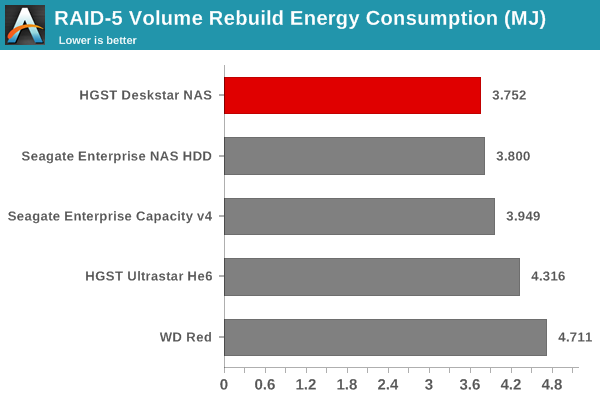
While the energy consumption aspect provides a consolidated view of the various factors, it is still worthwhile to look at the power consumption and resync duration numbers separately. The table below provides the raw information behind the above graph. We had a brief inkling when the temperature of the Deskstar NAS remained around 40 C only, despite more than 240 GB of continous data traffic, but the above energy consumption numbers confirm the fact that the Deskstar NAS is indeed quite efficient. That said, the raw power numbers do not look good for the Deskstar NAS in the table below. However, by getting done with the workloads earlier, the drive can go to the idle state quickly and keep system energy consumption resonable in the long run.
| RAID-5 Resync Power Consumption & Duration | ||
| Drive | Power (W) | Duration (s) |
| HGST Deskstar NAS | 101.46 | 36981 |
| WD Red | 90.48 | 52072 |
| Seagate Enterprise NAS HDD | 101.91 | 37284 |
| HGST Ultrastar He6 | 95.36 | 45260 |
| Seagate Enterprise Capacity v4 | 105.42 | 37462 |
We also measured power consumption during the last stage of our multi-client test. With 25 different clients simultaneously stressing the NAS with different types of workloads, we recorded the power consumption at the wall for the NAS as a whole. The various numbers are presented in the graphs below.
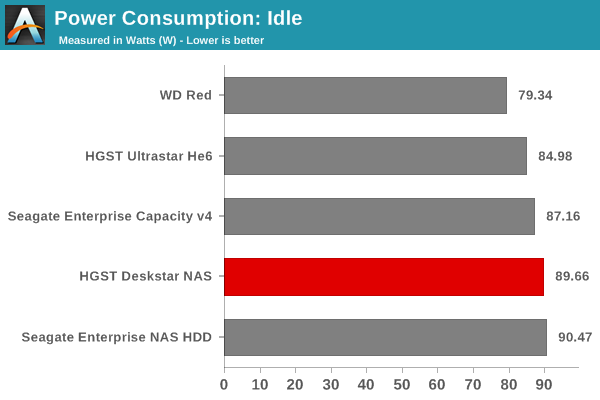
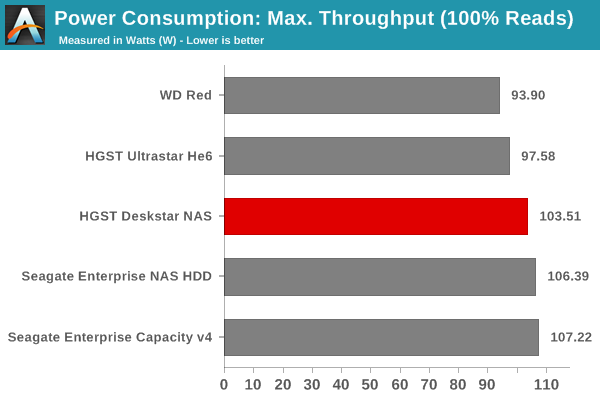
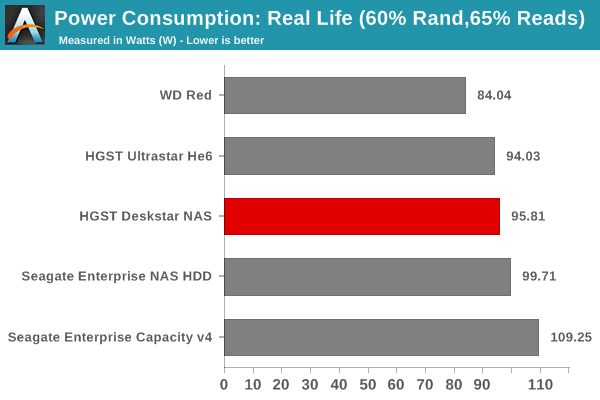
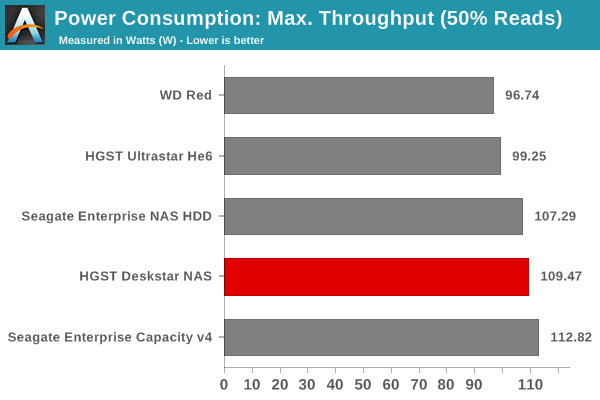

As expected, the units providing better performance have higher power consumption numbers. Amongst the 7200 RPM drives, the Ultrastar He6 is the most power-efficient. This is due to the HelioSeal technology (disks spinning in a sealed chamber filled with helium). Amongst the conventional drives, the Deskstar NAS manages to be the most power efficient for a few of the access patterns.










36 Comments
View All Comments
Guspaz - Tuesday, December 23, 2014 - link
$300 for a 6TB drive doesn't seem very cost-effective when 8TB drives sell for $260, and 4TB drives sell for $140. Heck, even the 4TB HGST DeskStar NAS sells for only $165. This isn't really a fault with the HGST drive specifically (since other 6TB drives aren't any cheaper), but more a fault with the 6TB capacity point.Of course, the 8TB drive in question is using SMR, and so ought to be rather slow for writes, but when you've got a bunch of them in a server with some SSDs for caching, it shouldn't be so bad.
insz - Tuesday, December 23, 2014 - link
Can you please provide a link to an 8TB drive for $260?Dreamwalker - Tuesday, December 23, 2014 - link
Here in EU you can get the Seagate Archive 8TB for ~226EUR (275USD with vat). It targets cloud/cold storage market but I think it should be great for a HTPC too...https://geizhals.at/eu/seagate-archive-hdd-v2-8tb-...
patrioteagle07 - Tuesday, January 6, 2015 - link
You do not want that drive... it is cheap because it is SMR. SMR is for COLD storage not NAS.BeAi - Wednesday, January 7, 2015 - link
Hi there, we are Premium Reseller of HGST, about these disks i could give some more inputs... First, the Seagate is a SMR Disk, only good for Backupszenarios, further they have only 3 years warranty.The HGST 8TB Disk is not a SMR Disk, HGST has got the 10 TB SMR Disk for Backupsolutions. Than the HGST Disk have got 5 Years warranty, for business solutions is that an argument. Last but not least, HGST has released on all SAS3 Disk the Media Caching Technologie, the disk are probably up to 3 times faster than other disk on the market. We have tested disks in our Lab, with a 1.2TB media caching 10k Disk, it will be faster than a 15k normal 2,5 inc disk. For more information, feel free to visit our online Shop: shop.storagespace.ch Kind Regards.
BeAi - Wednesday, January 7, 2015 - link
Sorry i have forget that the HGST 8TB also have the Helium 8 Technologie, its also a He8 Plate, the Seagate havent got helium inside...Benefit of HGST Helium: up to 50% less energy cost, and less heat from the plate... If you wanna have an offer or more informations: info@storagespace.ch
takeshi7 - Tuesday, December 23, 2014 - link
I think he's citing this article. That $260/8TB is bulk pricing for buying 20 drives it looks like.http://www.extremetech.com/computing/195543-seagat...
nandnandnand - Tuesday, December 23, 2014 - link
The $260 8 TB drive isn't out yet. But it is a good thingrealwarder - Friday, December 26, 2014 - link
Having a higher performance 6TB drive now is worth the extra money in the time saved over upgrading a 4TB drive later. It may be twice the price, but in $ it's not really much compared to reworking an entire setup later to add storage (unless you have a 8+ disk array with lots of room to grow)hlmcompany - Tuesday, December 23, 2014 - link
Regardless of the capacity, this HGST drive is in the same category as a WD Red Pro, NOT a WD Red.